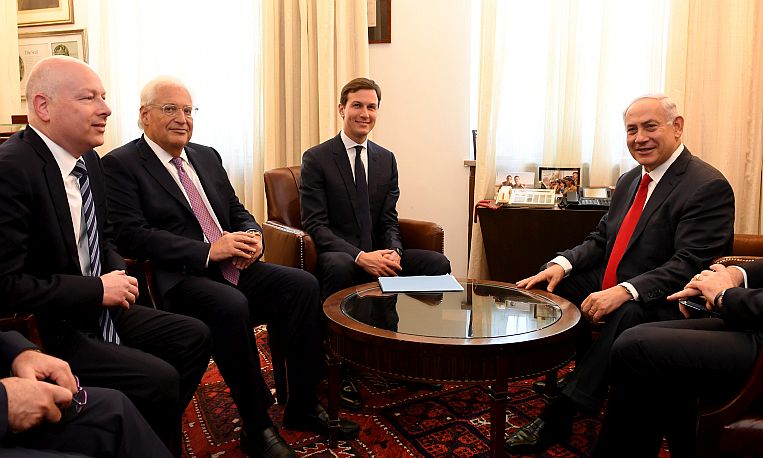Netanyahu has told the cabinet there are still no “concrete” US peace plans to consider, and bitter relations between Palestinians and the Trump Administration make early release less likely.
By: Steve Leibowitz, World Israel News
Following his latest White House meeting with President Donald Trump, Prime Minister Benjamin Netanyahu returned to tell the cabinet there are still “no concrete details” to report on the US peace plan. In all likelihood, Ambassador Friedman’s public clash with PA leader Mahmoud Abbas, and his cursing Friedman as the “son of a dog” is likely to shelve the peace plan for the foreseeable future.
Trump’s senior advisor and son-in-law Jared Kushner and a small White House team have spent the past year preparing a much-awaited blueprint for peace, but no details have emerged.
There have been plenty of leaks, including seemingly detailed proposals listed by Palestinian negotiator Saeb Erekat, but according to Netanyahu, as reported by Channel 10 TV, “At the moment, there is no concrete American peace plan on the table. I’m not saying there won’t be, but at the moment there isn’t.”
Trump held back details of his plan and the issue of the peace process was barely discussed, Netanyahu said. “Very little time was spent discussing a peace plan. The issue of the Palestinians came up only in regard to security questions, and not more than a quarter of the time we spent together related to the Palestinians.”
The UAE-based Al Khaleej online reported that top Israeli and Saudi Arabian officials held a series of secret meetings in Cairo, in anticipation of Trump’s unveiling of his long-awaited plan.
Before Abbas’s recent anti-US comments, especially calling Ambassador David Friedman a “son of a dog,” the Egyptian media reported that the Trump administration would announce the main points of the peace plan in the coming weeks. Administration officials had said the plan was close to completion, but declined to give a timeline for when it would be published.
Trump himself has hinted that his decision to move the US embassy from Tel Aviv to Jerusalem would have a price, saying, “It’s part of an American effort to persuade Israel, especially the hardliners, to agree to possible concessions to the Palestinians.” The president has repeatedly said Israel will have to “pay a price” for the dramatic December 6 recognition of Jerusalem as its capital, though he has not detailed the concessions he has in mind.
By all appearances, Israel’s relationship with the White House has never been better, buoyed by the Jewish state’s overwhelming support for Trump’s decision to relocate the US Embassy to Jerusalem and recognize the city as Israel’s capital. On the other hand, relations with the Palestinian Authority (PA) have never been more strained, causing the PA to break all diplomatic contacts with the White House following the Jerusalem announcement.
The only alleged detailed account of the Trump peace plan was released by Palestinian negotiator Saeb Erekat, who said that the Palestinians reject the plan’s main points. According to Erekat, the plan includes:
— Recognition of Jerusalem as Israel’s capital and moving the US embassy to the city.
Erekat said the Palestinians would have to accept Israeli annexation of eastern Jerusalem, and a Palestinian capital would “be invented” in the suburbs of Jerusalem that are within the Palestinian Authority.
— The Trump administration will announce within a period of two-to-three months its recognition of the annexation of settlement blocs.
Trump is allegedly proposing that Israel annex 10 percent of Judea and Samaria, including large Jewish “settlement” blocs. Netanyahu reportedly wants to annex 15 percent.
— The Trump administration would create a joint security concept for Israel and the Palestinian state as peace partners. The concept would include: The establishment of a demilitarized Palestinian state with a strong police force; Israeli forces remaining along the Jordan River and “central hills” in Judea and Samaria to protect the two states while giving Israel overriding security responsibility for emergency cases.
This is generally the Israeli concept of “defensible borders” that have long been part of Netanyahu’s concept for peace with the Palestinians.
— An Israeli withdrawal and gradual redeployment outside Areas ‘A’ (currently under full Palestinian control) and ‘B’ (currently under joint control) of Judea and Samaria, while handing over control of some territories from Area ‘C ‘(currently under Israeli control) to the PA. At a future date, based on the performance of the PA, a Palestinian state would be announced within these borders.
Israeli settlements are overwhelmingly located inside Area C. This concept would expand areas under Palestinian control but also allow for a vast majority of Jewish communities in Judea and Samaria to remain within Israel.
— The world would recognize Israel as the homeland of the Jewish people; the world would recognize the Palestinian state as the homeland of the Palestinian people.
Israel has long advocated for this.
— Parts of the Ashdod and Haifa ports and Ben Gurion Airport would be allocated for Palestinian use, while security responsibility would remain in the hands of Israel. A safe passageway would be opened between Judea and Samaria and the Gaza Strip under Israeli sovereignty.
This goes back to provisions that Israel generally accepted in the Oslo Accords and during negotiations with the Palestinians.
— A just solution would be found for the issue of the refugees in the context of the future Palestinian state.
“Refugees” would not be allowed to “return” to Israel.
Some Israeli analysts say that Israel would be quite pleased if details included above were to become the official US peace plan. For now, officials are remaining tight-lipped because changes could still be in the offing. In all likelihood, the White House has yet to release its peace plan because they are looking for ways to tweak the details in order to entice the Palestinians back to the table. At this stage, are only moving further away from negotiations.


